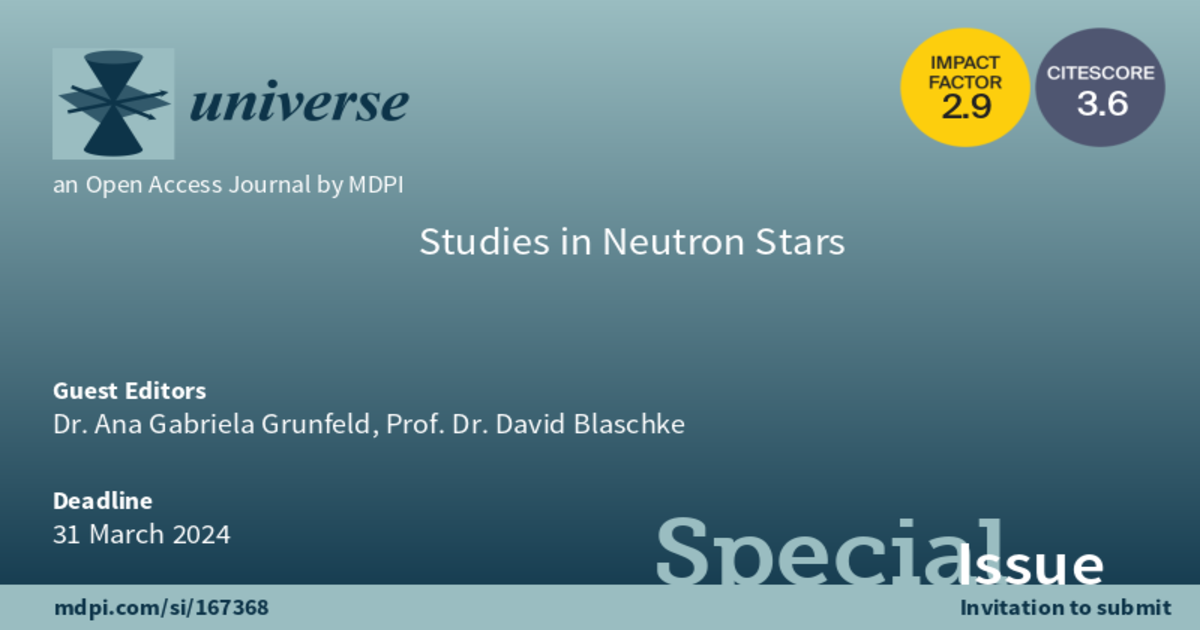Studies in Neutron Stars
A special issue of Universe (ISSN 2218-1997). This special issue belongs to the section "Compact Objects".
Deadline for manuscript submissions: closed (31 March 2024) | Viewed by 2403

Special Issue Editors
2. CONICET, Godoy Cruz 2290, Ciudad Autónoma de Buenos Aires C1425FQB, Argentina
Interests: chiral effective models; finite temperature and density; QCD phase diagram; compact objects; magnetic fields
2. Center for Advanced Systems Understanding (CASUS), D-02826 Görlitz, Germany
3. Helmholtz-Zentrum Dresden-Rossendorf (HZDR), D-01328 Dresden, Germany
Interests: quantum field theory at finite temperature; dense hadronic matter and QCD phase transitions; quark matter in heavy-ion collisions, in compact stars, their mergers and in supernova explosions; pair production in strong fields
Special Issues, Collections and Topics in MDPI journals
Special Issue Information
Dear Colleagues,
With the detection of the gravitational wave signal from the inspiral phase of the binary neutron star merger GW170817 by the LIGO-Virgo Collaboration in 2017, the new era of multi-messenger astronomy has begun. In this new era, neutron stars (NSs) play a crucial role, be it as pulsars in isolation or in binaries, as magnetars, as proto-neutron stars after supernova explosion or as companions in a merger.
NSs are the only objects whose emission encompasses all the available multi-messenger tracers: electromagnetic waves, cosmic rays, neutrinos, and gravitational waves (GW). They are the only laboratories where we can study the most extreme phases of matter: not only can we probe extremes of gravity and electromagnetism, but also, strong and weak interaction can be studied in regimes that we cannot hope to explore on Earth. The study of these objects transcends the traditional astrophysical approach and requires a multidisciplinary effort that spans from particle and nuclear physics to astrophysics, from experiment to theory, from gravitational waves to the electromagnetic spectrum.
The purpose of this Special Issue is to collect new original contributions as well as reviews in the broad field of NS studies. We welcome contributions exploring all aspects of NSs, from theories to observations. Submit your paper and select the Journal “Universe” and the Special Issue “Studies on Neutron Stars” via: MDPI submission system. Papers will be published on a rolling basis, and we will be pleased to receive your contributions when they are ready to be submitted.
Dr. Ana Gabriela Grunfeld
Prof. Dr. David Blaschke
Guest Editors
Manuscript Submission Information
Manuscripts should be submitted online at www.mdpi.com by registering and logging in to this website. Once you are registered, click here to go to the submission form. Manuscripts can be submitted until the deadline. All submissions that pass pre-check are peer-reviewed. Accepted papers will be published continuously in the journal (as soon as accepted) and will be listed together on the special issue website. Research articles, review articles as well as short communications are invited. For planned papers, a title and short abstract (about 100 words) can be sent to the Editorial Office for announcement on this website.
Submitted manuscripts should not have been published previously, nor be under consideration for publication elsewhere (except conference proceedings papers). All manuscripts are thoroughly refereed through a single-blind peer-review process. A guide for authors and other relevant information for submission of manuscripts is available on the Instructions for Authors page. Universe is an international peer-reviewed open access monthly journal published by MDPI.
Please visit the Instructions for Authors page before submitting a manuscript. Submitted papers should be well formatted and use good English. Authors may use MDPI's English editing service prior to publication or during author revisions.
Keywords
- neutron star cooling
- quark matter in neutron stars
- bayesian analysis
- binary neutron star mergers
- hypernuclear matter
- gravitational waves
- NICER
- strange dwarfs
- mass twin stars
- perturbative QCD





